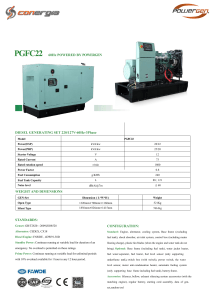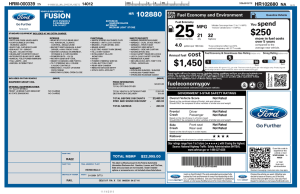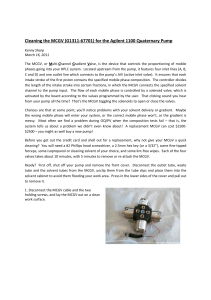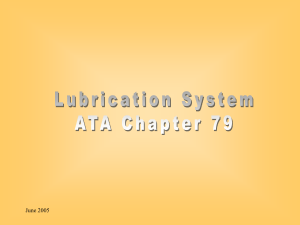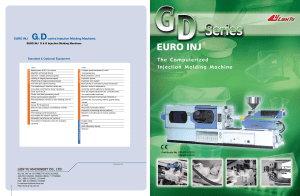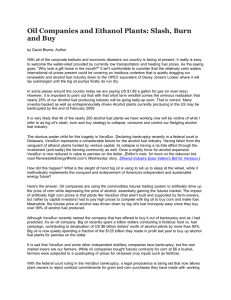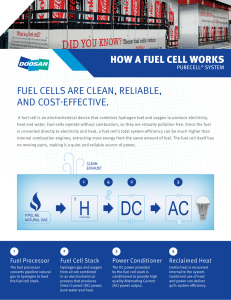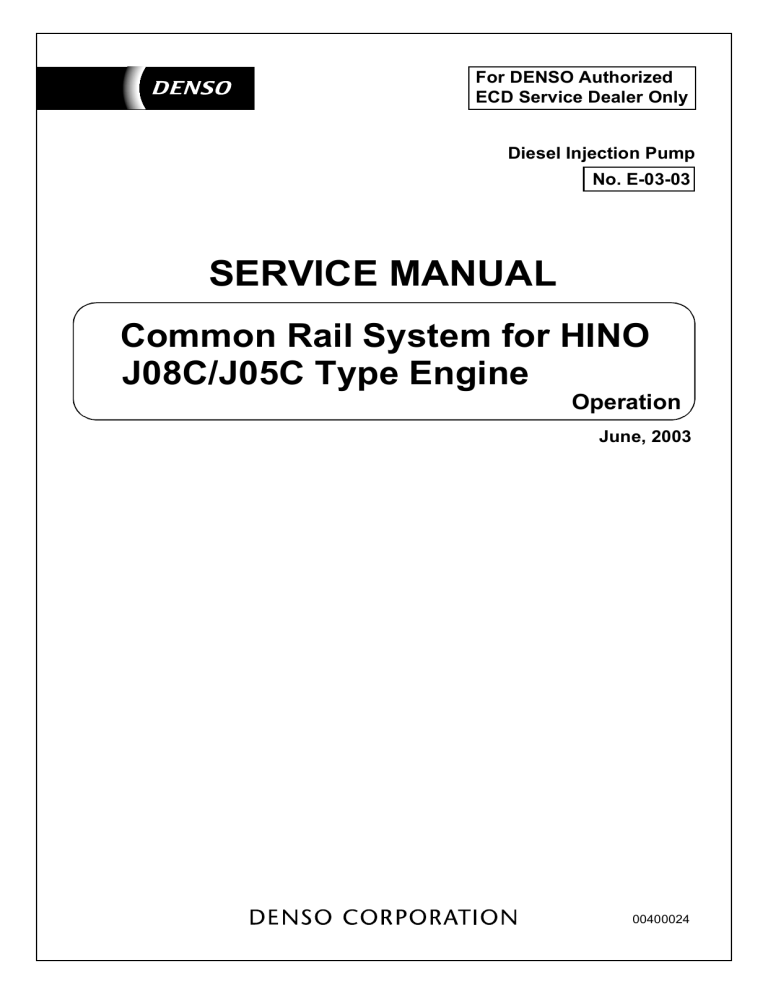
For DENSO Authorized ECD Service Dealer Only Diesel Injection Pump No. E-03-03 SERVICE MANUAL Common Rail System for HINO J08C/J05C Type Engine Operation June, 2003 00400024 -1 GENERAL The ECD-U2 was designed for electronic control of injection quantity, injection timing and injection pressure to obtain optimal operational control. Features Lower exhaust gas and higher output due to high pressure injection in all usage ranges. Reduction in noise and exhaust gas due to injection rate control. Improved performance due to increased flexibility in the injection timing setting. Independent control of injection pressure in response to engine speed and load. Main Elements Manufacturer Hino Motor, Ltd. Total Maximum Output Cylinder Displacement (PS/rpm) Configuration (cc) Vehicle Model Engine Model HR1J J08C Straight 6 7,961 RX4JFE J05C Straight 4 5,307 J-N: 205/2,900 J-V: 220/2,900 175/2,900 Main Components Part Number No. 1 Description Supply pump Cylinder recognition 1-1 sensor 2 Injector 3 Rail 3-1 Rail pressure sensor 3-2 Pressure limiter 3-3 Flow damper HR1J (J08C-UC) DENSO P/N HINO P/N 094000-0183 22730-1042A RX4JFE (J05C-TG) DENSO P/N HINO P/N 094000-0193 22730-1072A 029600-0580 89411-1290A1 029600-0580 89411-1290A1 095000-0174 23910-10033C 095000-0174 23910-10033C 095440-0243 22760-1100C 095440-0171 22760-1041C 499000-4441 499000-4441 095420-0060 095420-0060 095400-0150 095400-0150 0 1. Outline 1.1 System Outline This system also provides the following functions: A self-diagnosis and alarm function using computer to diagnose the system s major components and alert the driver in the event of a problem. A fail-safe function to stop the engine, depending upon the location of the problem. A backup function to change the fuel regulation method, thus enabling the vehicle to continue operation. 1.2 System Configuration Divided by function, the system can be classified according to the fuel system and the control system. [1] Fuel System High-pressure fuel that is generated by the supply pump is distributed to the cylinders using a rail. Electromagnetic valves in the injectors then open and close the nozzle needle valve to control the start and end of fuel injection. [2] Control System Based on the signals received from various sensors mounted on the engine and the vehicle, the ECU controls current timing and the duration in which the current is applied to the injectors, thus ensuring an optimal amount of fuel is injected at an optimal time. The control system can be broadly classified according to the following electronic components: sensors, computers, and actuators. 1 [3] System Configuration (1) 2 [4] System Configuration (2) 3 1.3 Construction and Operation of the System The rail system is comprised of a supply pump, a rail, and injectors, and also includes an ECU and sensors to regulate those components. The supply pump generates the internal fuel pressure in the rail. Fuel pressure is regulated by the quantity of fuel discharged by the supply pump. In turn, the fuel discharge quantity is regulated by electronic signals from the ECU that turn the PCVs (pump control valves) ON and OFF. Upon receiving fuel pressurized by the supply pump, the rail distributes the fuel to the cylinders. The pressurized fuel is detected by the rail pressure sensor (installed in the rail) and undergoes feedback control so that actual pressure will match the command pressure (designated according to the engine speed and load). Pressurized fuel in the rail passes through the injection pipes that lead to the cylinders, and applies pressure to the injector nozzles and the control chamber. The injector regulates injection quantity and timing by turning the TWV (two-way valve) ON and OFF. When the TWV is ON (current applied), the fuel circuit switches over, causing the high-pressure fuel in the control chamber to flow out via the orifice. As a result, the force of the high-pressure fuel at the nozzle valve opening causes the needle valve to lift, thus starting the injection of fuel. When the TWV is turned OFF (current not applied), the fuel circuit switches over so that highpressure fuel, traveling via the orifice, is introduced to the control chamber. As a result, the needle valve lowers, thus ending the injection of fuel. Thus, through electronic control, the timing of the current applied to the TWV determines the injection timing, and the duration in which current is applied to the TWV determines the injection quantity. 4 1.4 Comparison to Conventional Pump 5 2. Construction and Operation of Components 2.1 Supply Pump [1] Outline The function of the supply pump is to regulate the fuel discharge volume, thus generating internal fuel pressure in the rail. [2] Construction The supply pump consists of a feed pump, similar to that of the conventional in-line pump, and the PCVs (pump control valves), provided at each cylinder, to regulate the fuel discharge volume. The supply pump uses a three-lobe cam or two-lobe cam reducing the number of pump cylinders to one-third or one-second of the engine cylinders (e.g. a two-cylinder pump for a six-cylinder engine or for a four-cylinder engine). Furthermore, a smooth and stable rail pressure is obtained because the rate at which fuel is pumped to the rail is the same as the injection rate. 6 [3] Operation A: The PCV remains open during the plunger s downward stroke, allowing low-pressure fuel to be drawn into the plunger chamber by way of the PCV. B: If the valve remains open because current is not applied to the PCV, even after the plunger begins its upward stroke, the fuel that was drawn in returns via the PCV, without being pressurized. C: When current is applied to the PCV in order to close the valve at the timing that accommodates the required discharge volume, the return passage closes, causing pressure in the plunger chamber to rise. The fuel then passes through the delivery valve (check valve) to the rail. As a result, an amount of fuel that corresponding to the plunger lift after the PCV closes becomes the discharge volume, and varying the timing of the PCV closure (plunger prestroke) varies the discharge volume, thus regulating rail pressure. A : After surpassing the maximum cam lift, the plunger begins its downward stroke, causing pressure in the plunger chamber to decrease. At this time, the delivery valve closes, thus stopping the pumping of the fuel. In addition, because current to the PCV valve is cut off, the PCV opens, allowing low-pressure fuel to be drawn into the plunger chamber. Thus, the pump assumes condition . 7 [4] PCV (pump control valve) The PCV regulates the volume of fuel discharged by the supply pump in order to regulate rail pressure. The volume of fuel discharged by the supply pump to the rail is determined by the time at which current is applied to the PCV. [5] Trochoid Type Feed Pump The feed pump, which is housed in the supply pump, draws fuel up from the tank and delivers it to the chamber via the fuel filter. The feed pump rotor is driven by the camshaft. The rotation of the camshaft causes the outer and inner rotors to rotate. At this time, the suction port side pump chamber volume (the space surrounded by the outer and inner rotors) increases gradually, causing the fuel entering from the fuel inlet to be drawn into the pump chamber via the suction port. Along with the rotation of the rotor, the fuel that has been drawn in moves towards the discharge port and is discharged. The discharged fuel travels via the fuel outlet and is fed into the supply pump body. [6] Coupling The coupling is an intermediary device that transmits the engine driving torque to the supply pump camshaft. 8 2.2 Rail [1] Construction The functionof the rail is to distribute the high-pressure fuel pressurized by the supply pump to each cylinder injector. The rail pressure sensor, flow damper, and pressure limiter are mounted on the rail. A fuel injection pipe is attached to the flow damper to deliver high-pressure fuel to the injector. The pressure limiter piping is routed back to the fuel tank. [2] Flow Damper The flow damper reduces pressure pulsation in the high-pressure pipe, thus delivering fuel to the injectors at a stable pressure. Furthermore, in the event an excessive flow of fuel, the flow damper shuts off the fuel passage, thus preventing the abnormal fuel flow. When abnormal amount of fuel flows the high-pressure is applied to the piston. As shown in the illustration, this causes the piston and ball to move right, until the ball reaches the seat and closes the fuel passage. [3] Pressure Limiter The function of the pressure limiter is to dispel abnormally high pressure by opening its valve to release pressure. The pressure limiter operates (opens the valve) when rail pressure reaches approximately 140MPa. Then, when the pressure decreases to approximately 30MPa, the pressure limiter resumes (closes the valve) its function to maintain pressure. NOTE: Do not attempt to remove or to reinstall the flow damper, pressure limiter, and the rail pressure sensor. 9 [4] Rail Pressure Sensor The rail, the rail pressure sensor is mounted on the rail and detects the fuel pressure. It is a semi-conductor type of pressure sensor that utilizes the properties of silicon to change its electrical resistance when pressure is applied. 2.3 Injector [1] Outline The function of the injector is to inject high-pressure fuel from the rail into the engine combustion chamber at the proper timing, quantity, ratio, and atomization, in accordance with signals from the ECU. The TWV (two-way solenoid valve) regulates pressure in the control chamber in order to control the beginning and end of injection. The orifice restrains the opening speed of the nozzle valve to regulate the injection ratio. The command piston transmits pressure from the control chamber to the nozzle needle valve. The nozzle atomizes the fuel. 10 [2] Construction The injector consists of the nozzle portion (similar to that of the conventional type), the orifice (which regulates the injection ratio), the command piston, and the two-way solenoid valve (TWV). 11 [3] Operation The TWV portion of the injector consists of two valves, an inner valve (fixed) and an outer valve (movable). Both valves are precision-fitted on the same axis. The valves respectively form inner and outer seats, and either of the seats opens selectively depending upon whether the TWV is ON or OFF. a. No Injection When no current is applied to the solenoid, the valve spring and hydraulic pressure forces push the outer valve downward, causing the outer seat to remain closed. Because the rail high pressure is applied to the control chamber via the orifices, the nozzle remains closed without injecting fuel. b. Begin Injection When current is applied to the TWV, the solenoid force pulls the outer valve upward, causing the outer seat to open. As a result, fuel from the control chamber flows out via the orifice, causing the needle to lift and fuel to start injection. Furthermore, the injection ratio increases gradually in accordance with the movement of the orifice. As the application of current continues to apply, the injector reaches its maximum injection ratio. c. End Injection When current to the TWV is cut off, the valve spring and hydraulic force (fuel pressure) cause the outer valve to descend and the outer seat closes. At this time, high-pressure fuel from the rail is immediately introduced into the control chamber, causing the nozzle to close suddenly. As a result, injection ends swiftly. 12 [4] Circuit Diagram 13 WARNING: High voltage is applied to the wires connected to COMMON1, COMMON2, and the TWV #1-#6 terminals of the ECU. Exercise extreme caution to prevent electric shock. 14 2.4 Sensors and Relays [1] NE Sensor (crankshaft position sensor) When the signal holes on the flywheel move past the sensor, the magnetic line of force passing through the coil changes, generating alternating voltage. The signal holes are located on the flywheel at 7.5-degree intervals. There are a total of 45 holes, with holes missing in three places. Therefore, every two revolutions of the engine outputs 90 pulses. This signal is used to detect the engine speed and the crankshaft position in 7.5-degree intervals. [2] TDC sensor (cylinder recognition sensor) Similar to the NE sensor, the sensor utilizes the alternating voltage generated by the changes in the magnetic line of force passing through the coil. The disc-shaped gear located in the center of the supply pump camshaft has a cog (U-shaped cutout) at 120-degree intervals, plus one tooth in an additional location. Accordingly, every two revolutions of the engine outputs seven pulses. The combination of the NE pulse, auxiliary pulse is recognized as the No. 1 cylinder reference pulse. A combination of the NE pulse and the TDC pulses are used for the cylinder reference pulse, and the irregular pulse is used to determine the No. 1 cylinder. 15 16 [3] Water Temperature Sensor (THW made another manufacturer) The water temperature sensor detects the temperature of the engine coolant water and outputs it to the ECU. The sensor uses a thermistor, which varies resistance according to temperature. As the ECU applies voltage to the thermistor, it uses a voltage resulting from the division of the computer internal resistance and the thermistor resistance to detect the temperature. [4] Fuel Temperature Sensor (THL) The fuel temperature sensor detects the fuel temperature and outputs it to the ECU. The sensor uses a thermistor, which varies resistance according to temperature. As the ECU applies voltage to the thermistor, it uses a voltage resulting from the division of the computer internal resistance and the thermistor resistance to detect the temperature. 17 [5] Atmospheric Air Presuure Sensor (Built-in ECU) This sensor converts the atmospheric air pressure into an electrical signal to correct full-load injection volume. [6] Accelerator Position Sensor This sensor converts the angle of the pedal effort applied to the accelerator pedal into electrical signals and sends them to the ECU. The accelerator sensor uses hall elements. A magnet is mounted on the shaft that moves in unison with the accelerator pedal, and the magnetic field orientation changes with the rotation of the shaft. The changes in the magnetic field orientation generate voltage. [7] Boost Pressure Sensor In order to correct the full-load injection volume, this sensor converts the intake air pressure (absolute pressure) into an electrical signal, then amplifies it into a voltage signal to the computer. 18 [8] Idle Set Button (made by another manufacturer) A control knob is provided within the driver s reach, enabling the driver to set the idle speed. [9] Main Relay To supply current to the ECU, the main relay points close when current is applied the main relay coil. [10] PCV Relay It is a relay that supplies current to the supply pump s PCV (discharge volume control valve). 19 3. Various Types of Control This system controls the fuel injection quantity and injection timing more optimally than the mechanical governor or timer used in conventional injection pumps. For system control, the ECU makes the necessary calculations based on signals received from sensors located in the engine and on the vehicle in order to control the timing and duration in which current is applied to the injectors, thus realizing optimal injection timing. [1] Fuel Injection Rate Control Function The fuel injection rate control function controls the ratio of the quantity of fuel that is injected through the nozzle hole during a specified period. [2] Fuel Injection Quantity Control Function The fuel injection quantity control function, replaces the conventional governor function, and controls fuel injection to achieve an optimal injection quantity based on the engine speed and the accelerator opening. [3] Fuel Injection Timing Control Function The fuel injection timing control function, replaces the conventional timer function, and controls the fuel injection to achieve an optimal injection timing according to the engine speed and the injection quantity. [4] Fuel Injection Pressure Control Function (Rail Pressure Control Function) The fuel injection pressure control function (rail pressure control function) uses a rail pressure sensor to measure fuel pressure, and feeds this data to the ECU to control the pump discharge quantity. Pressure feedback control is implemented to match the optimal quantity (command quantity) set according to the engine speed and the fuel injection quantity. 20 3.1 Fuel Injection Rate Control [1] Main Injection Same as conventional fuel injection. [2] Pilot Injection Pilot injection is the injection of a small amount of fuel prior to the main injection. While the adoption of higher pressure fuel injection is associated with an increase in the injection rate, the lag (injection lag) that occurs from the time fuel is injected until combustion starts cannot be reduced below a certain value. As a result, the quantity of fuel injected before ignition increases, resulting in explosive combustion together with ignition, and an increase in the amount of NOx and noise. Therefore, by providing a pilot injection, the initial injection rate is kept to the minimum required level dampening, the explosive first-period combustion and reducing NOx emissions. [3] Split Injection When the rotation is low at starting time, a small amount of fuel is injected several times prior to main injection. 21 3.2 Fuel Injection Quantity Control [1] Starting Injection Quantity The injection quantity is determined based on the engine speed (NE) and water temperature while starting, with the accelerator pressed 50% or more. [2] Transient Injection Quantity Correction When the changes in the accelerator opening are great during acceleration, the increase in fuel volume is delayed to inhibit the discharge of black smoke. [3] Basic Injection Quantity This quantity is determined in accordance with the engine speed (NE) and the accelerator opening. Increasing the accelerator opening while the engine speed remains constant causes the injection quantity to increase. [4] Injection Quantity for Maximum Speed Setting The injection quantity is regulated by a value that is determined in accordance with the engine speed. 22 [5] Maximum Injection Quantity This quantity is calculated by adding the amount of Qadjustment resistor correction and the amount of injection quantity fuel temperature correction to the basic maximum injection quantity that has been determined in accordance with the engine speed. [6] Amount of Q-Adjustment Correction Selects the one of eight values determined by data in ROM built in ECU. Characteristic curve is fixed by the value. [7] Amount of Injection Quantity Intake Pressure Correction Limits the maximum injection quantity in accordance with the intake pressure, in order to minimize the discharge of smoke when the intake air pressure is low. [8] Amount of Injection Quantity by Atmospheric Air Pressure Correction With using atmospheric air pressure sensor signal, the maximum injection quantity curve is corrected as shown in the right figure. 23 [9] Idle Speed Control System (ISC) Controls the idle speed by regulating the injection quantity in order to match the target speed, which has been calculated by the computer, with the actual speed. The functions of the ISC can be broadly divided into the following two items: Auto ISC Controls the idle speed in accordance with the water temperature. Manual ISC Controls the idle speed in accordance with the idle speed indicated on the manual idle setting knob provided at the driver s seat. Aircon Idle-up Control When the conditions shown in the chart on the right are realized, bring the idle-up speed to 735 rpm. [10] Auto Cruise Control Controls the actual vehicle speed by regulating the injection quantity in order to match the target speed that has been calculated by the computer with the actual speed. 24 3.3 Fuel Injection Timing Control The characteristics of the fuel injection timing vary depending on whether it is the main injection or the pilot injection. Although either the NE sensor or the auxiliary NE sensor is the reference for controlling the injection timing, the NE sensor is ordinarily used for this purpose. [1] Main Injection Timing The basic injection timing is calculated in accordance with the final injection quantity, the engine speed, and the water temperature (with map correction). While starting, it is calculated in accordance with the water temperature and the engine speed. [2] Pilot Injection timing (Pilot Interval) The pilot injection timing is controlled by adding the pilot interval to the main injection timing. The pilot interval is calculated in accordance with the final injection quantity, the engine speed, and the water temperature (with map correction). While starting, it is calculated in accordance with the water temperature and the engine speed. [3] Fuel Injection Pressure Control (1) Fuel Injection Pressure A value is calculated as determined in accordance with the final injection quantity and the engine speed. While starting, it is calculated in accordance with the water temperature and the engine speed. 25 1 2 3 4 1 2 3 13 13 13 13 14 14 14 4 3 12 16 2 12 3 1 12 2 1 11 16 2 9 16 3 8 1 1&2 8 16 2 8 6 1 8 2&4 1 7 14 3 6 14 1 6 4 2 4 1&3 1 4 14 1&2 3 14 NE sensor system abnormal 2 3 Rail pressure abnormal (control system) Rail pressure abnormal (excessive pumping by pump) Rail pressure abnormal (output fixed) Rail pressure abnormal (sensor system) PCV relay system abnormal PCV1 & 2 both GND shortf1 PCV1 & 2 both +B shortf1 PCV2 GND short PCV2 +B short PCV1 GND short PCV1 +B short Accelerator linked relay system abnormal Transmission retarder system abnormal Engine retarder relay system abnormal Exhaust brake solenoid valve system abnormal CBCS2 solenoid valve system abnormal CBCS1 solenoid valve system abnormal FSV solenoid valve system abnormal Vehicle speed sensor system abnormal Idle set button abnormal Accelerator position sensor 1 or 2 fixed voltage abnormal Both accelerator position sensors voltage abnormal Accelerator position sensor 2 voltage abnormal Accelerator position sensor 1 voltage abnormal Intake air pressure sensor system abnormal Engine stop switch system abnormal Starter switch system abnormal Fuel temperature sensor abnormal Coolant temperature sensor abnormal Both NE and TDC sensors abnormal TDC sensor system abnormal Normal 1 Meaning of the diagnostic trouble code (DTC) or the diagnosis item 3 Exhaust brake light 1 No. 4. Diagnostic Trouble Codes Wiring harness open circuit, short, or defective sensor Wiring harness open circuit, short, or defective relay Wiring harness open circuit, short, or defective solenoid valve / relay Light ON [1] Light ON [1] Light ON [1] Light ON [1] Blinking Blinking Blinking Light ON [1] Light ON [1] Light ON [1] Light ON [1] Light ON [2] Light ON [2] Yes* Yes* Limit injection quantity Normal control Stopped Stopped Limit injection quantity Normal control Limit injection quantity Normal control Wiring harness open circuit, short, or defective solenoid valve When an improper ECU is installed on the vehicle Normal control Wiring harness open circuit, short, or defective sensor Control continued with the normal accelerator position sensor Backup with idle set button Control continued using accelerator position sensor 1 Fixed to voltage of 0.2V when setting manually Light ON [2] Blinking Light ON [2] Control continued using accelerator position sensor 2 Wiring harness short Wiring harness open circuit, short, or defective sensor Light ON [2] Control continued as intake air pressure of 100kPa Normal control Stopped Stopped Stopped Stopped Stopped Normal control Stopped Stopped Normal control Stopped Stopped Cruise control Normal control Normal control Normal control Normal control Normal control Normal control Normal control Normal control Normal control Normal control Stopped Normal control Tachometer * The multiplex display screen indicates Engine . Normal control Normal control Stopped Normal control Normal control Normal control Normal control Normal control Normal control Normal control Control continued according to the coolant temperature sensor data Stopped Control continued as 80 °C during normal operation and as -20 °C during starting Normal control Exhaust brake engine retarder Contents of fail-safe action Engine stopped Control by NE sensor Control by TDC sensor Fuel injection Wiring harness open circuit, short, or defective sensor Yes* Yes* Multiplex indication Switch input invalidated Light ON [2] Blinking Light ON [2] Light ON [2] Warning light [mode] Switch seized or wiring harness short Wiring harness open circuit, short, or defective sensor Wiring harness open circuit, short, or defective sensor Estimated cause of the malfunction Exhaust brake light 1 2 3 4 5 6 1 2 3 4 5 6 1 2 3 4 1 2 1 2 3 1 1 No. 17 17 17 17 17 17 18 18 18 18 18 18 19 19 19 19 21 21 22 22 22 23 24 Overheating Overrun abnormal Atmospheric pressure sensor open/short CBCS solenoid system abnormal ECU internally abnormalal Pump not pumping or pressure limiter activated Pump not pumping (fuel discharged) Injector solenoid valve drive system GND short (common 2) Injector solenoid valve drive system +B short (common 2) Injector solenoid valve drive system GND short (common 1) Coolant temperature over 105 °C Engine speed over 3,650 rpm Light ON [1] Light ON [2] ECU defective Light ON [1] Wiring harness open circuit, short, defective solenoid valve, or improper ECU installation Blinking Blinking Light ON [1] Light ON [1] Light ON [1] ECU defective Significant misalignment during the assembly of the supply pump Wiring harness short Light ON [1] Light ON [1] Injector solenoid valve drive system open circuit (No. 6 cylinder) - For J08C only Injector solenoid valve drive system +B short (common 1) Light ON [1] Injector solenoid valve drive system open circuit (No. 5 cylinder) - For J08C only Light ON [1] Light ON [1] Injector solenoid valve drive system open circuit (No. 3 cylinder) Injector solenoid valve drive system open circuit (No. 4 cylinder) Light ON [1] Injector solenoid valve drive system open circuit (No. 2 cylinder) Warning light [mode] Light ON [1] Wiring harness open circuit Fuel leak Estimated cause of the malfunction Injector solenoid valve drive system open circuit (No. 1 cylinder) Flow damper activated (No. 6 cylinder) - For J08C only Flow damper activated (No. 5 cylinder) - For J08C only Flow damper activated (No. 4 cylinder) Flow damper activated (No. 3 cylinder) Flow damper activated (No. 2 cylinder) Flow damper activated (No. 1 cylinder) Meaning of the diagnostic trouble code (DTC) or the diagnosis item Yes* Yes* Multiplex indication Limit injection quantity Stopped Stopped Normal control Stopped Stopped Stopped Stopped Stopped Normal control Cruise control Normal control Normal control Normal control Normal control Stopped Normal control Normal control Normal control Normal control Tachometer * The multiplex display screen indicates Engine . Normal control Normal control Normal control Fix atmospheric air pressure to 101.3 kPa Injection stopped during overrun Normal control Stopped Normal control Normal control Normal control Normal control Exhaust brake engine retarder Limit injection quantity Limit injection quantity Injection quantity limited; then, stopped Limit injection quantity Limit injection quantity Injection stopped to the cylinder in which the flow damper has been activated Fuel injection Contents of fail-safe action


